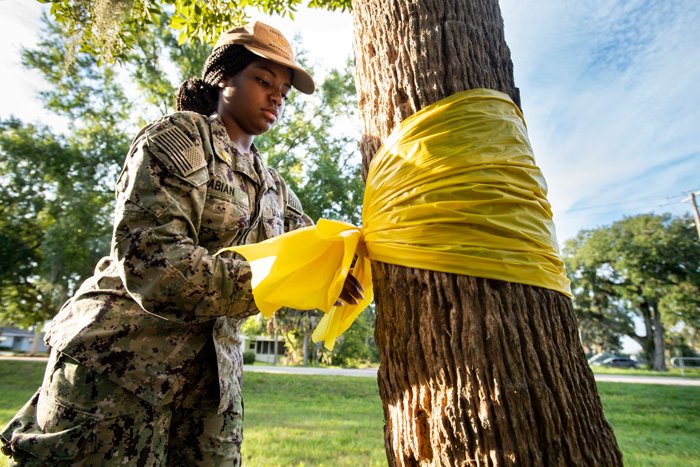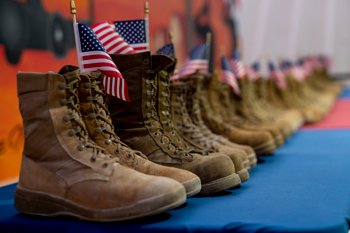‘Invisible’–More Women Veterans Are Dying of Suicide and VA Still Lacks Resources, Advocates Say
Active-duty service members and veterans thinking of harming themselves can get free crisis care. Contact the Military Crisis Line at 988, then press 1, or access online chat by texting 838255.
When she joined the Navy in 2001, Jennifer Alvarado wanted to excel, to be, in her words, a “stellar sailor.” After boot camp, she worked as a hospital corpsman and pursued extra medical and weapons certification courses to prove her work ethic.
Her home life on the military base was a different story: She hid the stress and increasing danger of her relationship with her husband from everyone. One evening in 2005, with her two small boys in the apartment, Alvarado argued with her husband and the altercation turned violent. He beat her, she said in a recent phone interview, and then stormed out and took her car. She called the police on the military base. “My secret was out in the open,” she said. “The shame just came out of my pores.”

Jennifer Alvarado is a Navy veteran. After separating from the Navy, she experienced a difficult transition and suicidal thoughts. Photo courtesy of William Hendra Photography/DAV.
Her command didn’t provide long-term mental health support for post-traumatic stress, she said. Alvarado gained weight, struggled with anger and fatigue, and, in 2006, her command ultimately pushed her to medically separate from the Navy.
“I didn’t want to do it,” she says. “I wanted to remain in the military. The thought of getting out scared the crap out of me.”
Alvarado’s transition into civilian life was abrupt and isolating, made even more difficult by leaving the abusive relationship and once again being a single mom to two young children.
She drank heavily, couldn’t sleep, and at times, she thought about killing herself. “I felt that the world would be a better place without me,” she said, “and felt that my kids would have a better life without me.”
According to VA’s 2023 annual suicide prevention report, a growing number of women veterans are dying by suicide. The suicide rate for female veterans has nearly doubled in the two decades from 2001 to 2021, the most recent year with data available. Between 2020 and 2021 alone, the rate increased 24%—nearly four times the 6.3% rise in the suicides of male veterans. And the number of women calling or texting the Veterans Crisis Line has also risen, to nearly 83,000 in 2023 from 70,316 women in 2021.
Addressing suicide has been a top priority for the Department of Veterans Affairs, but a recent report from Disabled American Veterans, an advocacy organization, argues that VA still lacks adequate supports and screening measures for female veterans. For instance, an algorithm used by VA to detect women in their system who are most at risk for suicide does not include military sexual trauma (MST) as a risk factor, despite MST’s link to heightened suicide risk among women veterans. The disabled veterans group’s report also found gaps in training for community care providers who care for female veterans, and a lack of gender-specific treatment facilities.
Hyeouk Chris Hahm, an associate dean for research at Boston University’s School of Social Work, said the jump in suicide rates of women veterans is “shocking” because it shows that within VA, “there is a lack of systems that (have) been built to protect these lives.” She added that it’s as if female veterans are “invisible.”
Filling the Gaps
The increase in female veterans’ suicides even surprised Naomi Mathis, the assistant national legislative director for Disabled American Veterans. When VA released its most recent suicide report last fall, DAV began a review of existing peer-reviewed research to identify gaps for women veterans who might be at risk for suicide.
Mathis said it’s critical that VA fill those gaps because, since 2005, the agency has seen a 154% increase in the number of women veterans accessing VA for mental health care. “The VA has to be able and be prepared to handle that,” she said, and while female veterans currently only make up a fraction of the nation’s 18 million veterans, women are the fastest growing cohort of veterans and are expected to make up 15% of the veteran population by 2035.
Award-Winning Journalism in Your Inbox
Women may not tell their health care providers about their military sexual trauma, Mathis said.
“One of the things that we found was that there were a number of false negative screens. So veterans aren’t feeling comfortable speaking with their provider,” she said.
Moreover, the algorithm that VA uses to predict suicidality and intervene with high-risk veterans “uses male veterans as its normative baseline,” the report said, excluding MST as a risk factor, despite VA’s own research indicating that one in three women veterans have experienced such trauma.

Personnel Spc. Seaman Jenesis Fabian, assigned to Naval Station Mayport, ties a yellow ribbon around a tree at Mayport Memorial Park in recognition of Suicide Awareness Month. Photo by U.S. Navy Mass Communication Spc. 3rd Class Alana Langdon.
Asked about the predictive algorithm, a VA spokesman, Terrence Hayes, said that when fine-tuning the algorithm, machine learning had to find the “optimal number of predictor variables” for it to work efficiently and effectively, and MST ultimately wasn’t included. An update to the algorithm is underway, but it has not yet determined if MST will be included, Hayessaid.
After separating from the Navy, Alvarado, whose story is included in the DAV report, ultimately settled in south New Jersey, about a 45-minute drive from the Philadelphia VA. About 10 years ago, she stopped going to VA for health care, largely because of sexual harassment she said she faced from other veterans when walking into the building.
The sexually charged comments were “detrimental” to her mental health, she said. She has since returned to VA for care, and while the department has increased efforts to make their medical centers inclusive for all genders, Alvarado said there are still so few women at the Philadelphia site that as a woman, “it’s kind of a lonely world out there.”
If We’re Not Looking at Geriatrics, ‘We’re in Trouble’
The suicide rate is not just increasing for women veterans; it is also rising among women who have not served in the military, though not to the same degree. According to the most recent data from the Centers for Disease Control and Prevention, suicide rates for American women rose 4% in 2022 from the previous year. Still, VA found that the rate of suicides involving firearms was nearly three times higher for female veterans than for women who were not veterans.

U.S. Airmen from the 332nd Air Expeditionary Wing honor the daily estimated number of veterans who take their own lives, symbolized by 22 pairs of boots in recognition of Suicide Prevention Month. Sept. 8, 2021. Photo by U.S. Air Force Senior Airman Karla Parra.
Hahm, of Boston University, said rising suicide rates in both civilian and veteran populations may partly result from loneliness and stress experienced during the pandemic, adding that the stress veterans carry from their time in the military may compound mental health challenges.
In its report, the DAV called on VA to require that community care providers who treat veterans be trained in suicide prevention, gun safety counseling, and evidence-based treatments for mental health conditions common among women veterans, such as MST-related post-traumatic stress.
Hayes, the VA spokesperson, said VA’s current contract with community care providers would not allow for such required additional training, though VA does encourage partners to take part in voluntary educational opportunities.
Alvarado and other women who spoke to The War Horse said their experiences with VA providers could vary widely between locations and even from year to year. In 2017, for instance, Jenna Carlton had just separated from the Navy when she found out she was pregnant. Upon giving birth to a colicky baby, she experienced exhaustion and depression.
She skipped her six-week postpartum appointment with her OBGYN, who was a community care provider because VA does not offer labor and delivery services. Neither VA nor her OBGYN mentioned postpartum depression to her, she said. “Someone reaching out and saying, hey, you know, like, here’s the screening for postpartum depression, and just coming to me and asking me like, are you OK, how’s the baby?” can help, Carlton said.
Our Journalism Depends on Your Support
In 2020, though, when she was pregnant with her second child, VA offered more consistent support, she said.
VA’s proposed 2025 budget includes a 9.3% increase in funding to continue expanding women’s health care, including hiring more maternity care coordinators, gynecological providers, and women’s mental health providers.
At a February presentation of the DAV report, Elizabeth Yano, director of VA’s Center for the Study of Healthcare Innovation, Implementation and Policy and a leader in women veterans health research, said VA also needs to prioritize the physical and mental health of aging female veterans. “The largest group of women veterans using the VA now average 65 years old,” she said. “If we’re not looking at menopause, if we’re not looking at geriatrics … we’re in trouble.”
A Modicum of Justice
On a recent Friday afternoon, Alvarado was driving back to New Jersey from a DAV conference in Virginia where VA Secretary Denis McDonough spoke at the opening session. “VA must be better to support women veterans mental health and to prevent suicide through gender-tailored care,” McDonough said at the conference, pointing to the organization’s new report as evidence.

Jennifer Alvarado shakes hands with VA Secretary Denis McDonough at a Disabled American Veterans conference. Photo courtesy of Jennifer Alvarado.
McDonough also recounted Alvarado’s story, saying he was glad she eventually returned to VA for the care she “so richly deserves.”
Alvarado was told beforehand that McDonough was going to include her in his speech, but she still cried when he told the story, she said, because had her command been better equipped to support her through her experience with domestic violence, rather than push her out, she believes she would’ve achieved her dream of a career as a Navy hospital corpsman. Instead, she said, she was “robbed” of that opportunity.
Sitting in the same room with VA’s top leader, and hearing him declare that the agency has been lacking in supporting women who have served struck Alvarado as a modicum of justice. “Which was pretty beautiful,” she said.
This War Horse investigation was reported by Anne Marshall-Chalmers, edited by Erica Goode, fact-checked by Jess Rohan, and copy-edited by Mitchell Hansen-Dewar. Abbie Bennett wrote the headlines.
Coverage of veterans’ health made possible in part by a grant from the A-Mark Foundation.





Comments are closed.